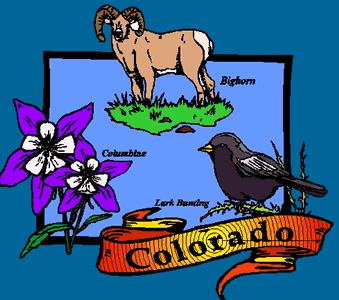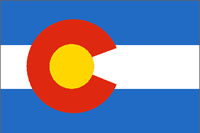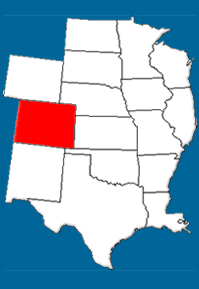 History:
Spanish explorers were the first Europeans to enter the region that is now Colorado. In the 16th century they came to the area to search for the wealthy Seven Cities of Cibola. After failing to find the legendary gold, they left without establishing any settlements.
In 1682, the explorer Robert Cavalier, Sieur de la Salle, claimed a portion of eastern Colorado for France as part of the Louisiana Territory. Spain subsequently claimed the region in 1706.
As a result of the Louisiana Purchase of 1803, the United States acquired eastern and central Colorado. Over the next 20 years, American military expeditions were sent into the new territory following routes opened years earlier by trappers and traders. Zebulon Pike, an army officer came to the territory in 1806, exploring and writing about the mountain that bears his name today - Pikes Peak.
In 1821, Mexico achieved its independence from Spain and took control of Colorado. Trouble gradually developed between Mexico and the United States as American colonists moved further into the southwest. The Mexican War began in 1846.
A permanent settlement was made at Bent's Fort - near present day La Junta - in 1833. It was founded by the Bent and St. Vrain Fur Company, and became one of the best-known trading posts in the West. But additional settlements were not formed in the area until the end of the Mexican War (1848) when the United States acquired the remainder of present-day Colorado in the Treaty of Guadalupe Hidalgo.
While many Americans traveled through Colorado territory on their way to the more fertile lands of California, Oregon, and Washington, few actually settled there. But in 1858, gold was discovered at Cherry Creek - near present-day Denver - and large numbers of prospectors began coming to the region.
Soon conflicts arose between the miners and the Native Americans, who claimed ownership of the land as a result of various treaties. The miners ignored these claims and established an illegal Jefferson Territory that was not officially recognized by Congress. In an effort to put an end to these conflicts and establish control of this rapidly growing area, the U.S. government created the Colorado Territory in 1861. William Gilpin was appointed first territorial governor.
Several significant battles between Native Americans and white settlers occurred in Colorado during the 1860s and 1870s. In 1864, the Colorado militia attacked a Cheyenne village, killing hundreds of Native American men, women, and children. It became known as the "Sand Creek Massacre" and was severely criticized by the U.S. government, which compensated the Indians for their losses.
Three years later, Native Americans attacked a small group of army scouts in eastern Colorado on the Arikaree River. The fighting went on for several days, until the scouts were saved by other troops.
The Meeker Massacre of 1879 was the last major conflict. Nathan Meeker, a reservation agent, was brutally killed by the Ute Indians. After the battle, Ouray, a respected Ute chief, was instrumental in helping to smooth relations between the Indian warriors and the white settlers.
In 1870, a railroad linking Denver to the Union Pacific in Cheyenne, Wyoming, helped revive the territory's economy after the decline in gold mining. While many early settlements became ghost towns, new cattle ranches and farms were established and within a decade, the population increased five-fold.
Colorado was admitted to the union as the 38th state in 1876 and John Routt was elected governor. During this time, silver ore was discovered at Leadville and a lagging mining industry was revived. But the prosperity was short-lived. In 1893, the U.S. government stopped buying silver from Colorado in response to a business slump across the nation. The government hoped to restore confidence in America's currency, which had been on a gold standard since 1873. As a result, silver prices dropped, mines closed, and many miners were out of work.
But the state continued to grow and progress despite its difficulties. A major deposit of gold was discovered at Cripple Creek, farmers began to experiment with new crops, and irrigation systems were expanded. By the early years of the 20th century, construction began on a railroad over the continental divide and the U.S. Mint in Denver produced its first coin. |









